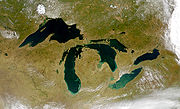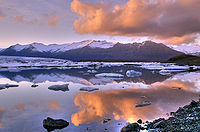
Glacial lake
Encyclopedia



Lake
A lake is a body of relatively still fresh or salt water of considerable size, localized in a basin, that is surrounded by land. Lakes are inland and not part of the ocean and therefore are distinct from lagoons, and are larger and deeper than ponds. Lakes can be contrasted with rivers or streams,...
with origins in a melted glacier
Glacier
A glacier is a large persistent body of ice that forms where the accumulation of snow exceeds its ablation over many years, often centuries. At least 0.1 km² in area and 50 m thick, but often much larger, a glacier slowly deforms and flows due to stresses induced by its weight...
. Near the end of the last glacial period
Glacial period
A glacial period is an interval of time within an ice age that is marked by colder temperatures and glacier advances. Interglacials, on the other hand, are periods of warmer climate within an ice age...
, roughly 10,000 years ago, glaciers began to retreat. A retreating glacier often left behind large deposits of ice in hollows between drumlins or hills. As the ice age ended, these melted to create lakes. This is apparent in the Lake District
Lake District
The Lake District, also commonly known as The Lakes or Lakeland, is a mountainous region in North West England. A popular holiday destination, it is famous not only for its lakes and its mountains but also for its associations with the early 19th century poetry and writings of William Wordsworth...
in Northwestern England
England
England is a country that is part of the United Kingdom. It shares land borders with Scotland to the north and Wales to the west; the Irish Sea is to the north west, the Celtic Sea to the south west, with the North Sea to the east and the English Channel to the south separating it from continental...
where post-glacial sediments are normally between 4 and 6 metres deep. These lakes are often surrounded by drumlins, along with other evidence of the glacier such as moraines, esker
Esker
An esker is a long winding ridge of stratified sand and gravel, examples of which occur in glaciated and formerly glaciated regions of Europe and North America...
s and erosion
Erosion
Erosion is when materials are removed from the surface and changed into something else. It only works by hydraulic actions and transport of solids in the natural environment, and leads to the deposition of these materials elsewhere...
al features such as striations
Glacial striations
Glacial striations or glacial grooves are scratches or gouges cut into bedrock by process of glacial abrasion. Glacial striations usually occur as multiple straight, parallel grooves representing the movement of the sediment-loaded base of the glacier...
and chatter mark
Chatter mark
A Chatter mark is one or, more commonly, a series of marks made by vibratory chipping of a bedrock surface by rock fragments carried in the base of a glacier...
s.
The scouring action of the glaciers pulverizes minerals in the rock over which the glacier passes. These pulverized minerals become sediment at the bottom of the lake, and some of the rock flour
Rock flour
Rock flour, or glacial flour, consists of fine-grained, silt-sized particles of rock, generated by mechanical grinding of bedrock by glacial erosion or by artificial grinding to a similar size...
becomes suspended in the water column. These suspended minerals support a large population of algae, making the water appear green.
These lakes are clearly visible in aerial photos of landforms in:
- Canada
- the northern US
- Russia
- the flat areas of Argentina
- Iceland
- southern New Zealand
- Tibet
- Scotland
- Norway
- Sweden
- Tasmania, Australia
and other regions that were glaciated during the last ice age
Ice age
An ice age or, more precisely, glacial age, is a generic geological period of long-term reduction in the temperature of the Earth's surface and atmosphere, resulting in the presence or expansion of continental ice sheets, polar ice sheets and alpine glaciers...
. The coastlines near these areas are typically very irregular, reflecting the same geological process.
By contrast, other areas have fewer lakes that often appear attached to rivers. Their coastlines are smoother. These areas were carved more by water erosion.
As seen in the English Lake District, the layers of the sediments at the bottom of the lakes can then tell you the rate of erosion by taking into account the rate of erosion of the glacier and its subsequent placement of the sediment. The elemental make up of the sediments are not associated with the lakes the themselves, but by the migration of the elements within the soil, such as iron and manganese.
The spreading of these elements, within the lake bed, are contributed to the condition of the drainage basin and the chemical composition of the water.
Sediment deposition can also be influenced by animal activity; including the distribution of biochemical elements, which are elements that are found in organic organisms, such as phosphorus and sulfur.
The less halogen and boron found in the sediments accompanies a change in erosional activity. The rate of deposition reflects the amount of halogen and boron in the deposited sediments.
See also
- Great LakesGreat LakesThe Great Lakes are a collection of freshwater lakes located in northeastern North America, on the Canada – United States border. Consisting of Lakes Superior, Michigan, Huron, Erie, and Ontario, they form the largest group of freshwater lakes on Earth by total surface, coming in second by volume...
- Glacial history of MinnesotaGlacial history of MinnesotaThe glacial history of Minnesota is most defined since the onset of the last glacial period, which ended some 10,000 years ago. Within the last million years, most of the Midwestern United States and much of Canada were covered at one time or another with an ice sheet. This continental glacier had...
- Proglacial lakeProglacial lakeIn geology, a proglacial lake is a lake formed either by the damming action of a moraine or ice dam during the retreat of a melting glacier, or by meltwater trapped against an ice sheet due to isostatic depression of the crust around the ice...
- Moraine-dammed lake
- Subglacial lakeSubglacial lakeA subglacial lake is a lake under a glacier, typically an ice cap or ice sheet. There are many such lakes, with Lake Vostok in Antarctica being by far the largest known at present.-Characteristics:...

